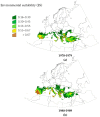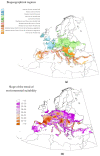Towards New Horizons: Climate Trends in Europe Increase the Environmental Suitability for Permanent Populations of Hyalomma marginatum (Ixodidae)
- PMID: 33494140
- PMCID: PMC7909578
- DOI: 10.3390/pathogens10020095
Towards New Horizons: Climate Trends in Europe Increase the Environmental Suitability for Permanent Populations of Hyalomma marginatum (Ixodidae)
Abstract
Ticks and tick-borne pathogens are changing their current distribution, presumably due to the impact of the climate trends. On a large scale, these trends are changing the environmental suitability of Hyalomma marginatum, the main vector of several pathogens affecting human health. We generated annual models of environmental suitability for the tick in the period 1970-2018, using harmonic regression-derived data of the daily maximum and minimum temperature, soil moisture and water vapor deficit. The results demonstrate an expansion of the suitable area in Mediterranean countries, southeast central Europe and south of the Balkans. Also, the models allowed us to interpret the impact of the ecological variables on these changes. We deduced that (i) maximum temperature was significant for all of the biogeographical categories, (ii) soil humidity has an influence in the Mediterranean climate areas, and (iii) the minimum temperature and deficit water vapor did not influence the environmental suitability of the species. The conclusions clearly show that climate change could create new areas in Europe with suitable climates for H. marginatum, while keeping its "historical" distribution in the Mediterranean. Therefore, it is necessary to further explore possible risk areas for H. marginatum and its associated pathogens.
Keywords: Europe; Hyalomma marginatum; climate trends; environmental suitability.
Conflict of interest statement
The authors declare no conflict of interest.
Figures





References
-
- Weber E.U. What shapes perceptions of climate change? Wiley Interdiscip. Rev. Clim. Chang. 2010;1:332–342. doi: 10.1002/wcc.41. - DOI
-
- Dennis D.T., Hayes E.B. Epidemiology of Lyme Borreliosis. In: Gray J.S., Kahl O., Lane R.S., Stanek G., editors. Lyme Borreliosis: Biology of the Infectious Agents and Epidemiology of Disease. CABI Publishing; Wallingford, UK: 2002. pp. 251–280.
LinkOut - more resources
Full Text Sources
Other Literature Sources

